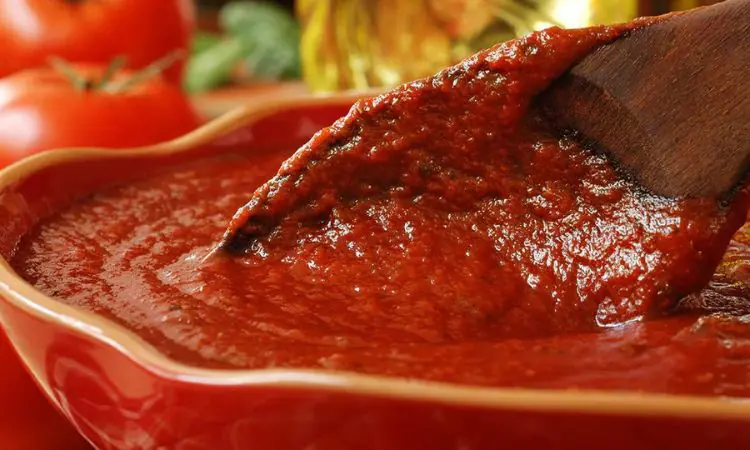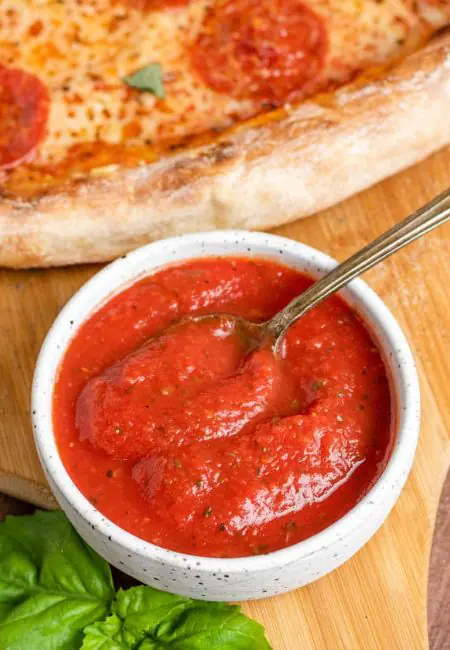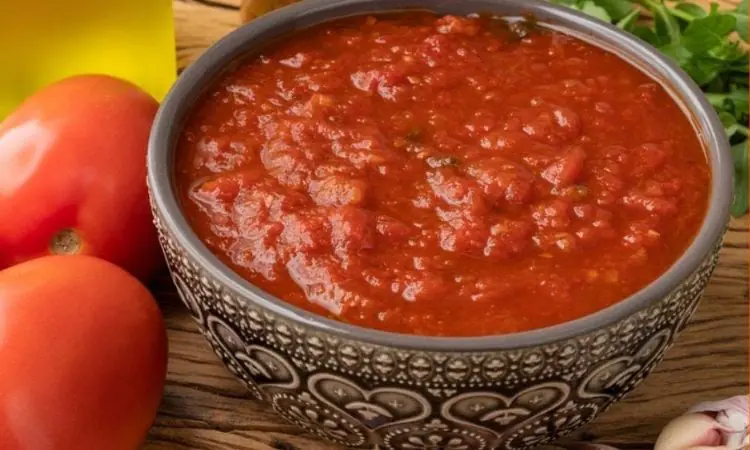Pizza sauce is typically uncooked and seasoned with herbs, while tomato sauce is cooked and has a more complex flavor profile. Understanding the differences can enhance your culinary experiences.
Pizza sauce is a vital ingredient that defines the character of your pizza; it’s a thick, robust condiment spread on the dough before baking. Tomato sauce, in contrast, is a versatile kitchen staple used in a variety of dishes, such as pasta, stews, and soups.
It undergoes a cooking process that allows the flavors to meld together, often with a base of sautéed onions and garlic. Pizza sauce, on the other hand, relies on the fresh zing of tomatoes and tends to be simpler, with a focus on ingredients like crushed tomatoes, salt, and essential herbs like oregano and basil. It’s crafted for a quick burst of flavor that complements the cheese and toppings without overpowering them. Knowing the subtle distinctions between the two sauces can influence the success of your dish, whether you’re whipping up a homemade pizza or a hearty pasta meal.
Pizza Sauce Vs. Tomato Sauce: The Basics
If you love cooking, you might wonder about the difference between pizza and tomato sauce. Although they seem similar, they have distinct features. Let’s explore what sets them apart.
Key Ingredients
The ingredients in pizza sauce and tomato sauce are different. Pizza sauce often includes a blend of tomatoes, herbs, and spices. On the other hand, tomato sauce might have a wider variety of ingredients like onions, garlic, and even carrots for a sweeter profile.
- Pizza Sauce:
- Crushed tomatoes
- Oregano
- Basil
- Garlic powder
- Salt
- Tomato Sauce:
- Tomato puree
- Chopped onions
- Minced garlic
- Vegetables like carrots
- Various herbs and spices
Texture And Consistency
The texture of pizza sauce and tomato sauce is another crucial difference. Pizza sauce is thicker, which allows it to stay on top of the dough easily. Tomato sauce is usually thinner, made for simmering and blending into pasta dishes.
| Sauce Type | Texture |
| Pizza Sauce | Thick and rich |
| Tomato Sauce | Smooth and more liquid |

Culinary Origins And History
The sauces we lavishly spread or pour over our foods carry rich histories. Among these sauces, the pizza sauce and tomato sauce are steeped in cultural significance. Each has a unique story originating from different gastronomic traditions.
Italian Roots
Italian cuisine is a celebration of regional flavors. It was here that tomato sauce began its journey. Although tomatoes came from the New World, Italians embraced them by the 18th century. The simple blend of tomatoes, garlic, herbs, and olive oil gave birth to the classic marinara.
Neapolitan pizza sauce, a variant specifically for pizza, evolved alongside. Chefs in Naples used raw tomatoes to create a spreadable sauce. This then married well with their invention, the modern pizza.
Evolution In American Cuisine
As Italian immigrants arrived in America, they brought their recipes. Yet, ingredients and tastes changed. American tomato sauce often has a sweeter twist. It also simmered longer.
Conversely, American pizza sauce clung to its Neapolitan roots. Its raw, vibrant qualities remained. Yet, it adapted to suit the toppings loved in the States. Thus, two distinctive sauces, each with its origin, continue to evolve, reflecting the culinary histories of the two nations.
Preparation Methods Explored
Let’s dive into the secrets that set pizza sauce and tomato sauce apart — the preparations. Knowing the difference ensures your Italian dishes taste authentic every time.
Cooked Vs. Uncooked
Pizza sauce often stars in its raw form. Fresh tomatoes blend with herbs and breathe life into any crust without the need for heat. This simplicity aids in a bright, vivid flavor that cooks alongside your pizza.
In contrast, tomato sauce simmers on the stove. Slow cooking marries the tang of tomatoes with onions, garlic, and olive oil. The result is a rich, deep taste perfected over hours.
Seasoning And Spices
- Bold Basil: A pizza sauce staple for that peppery sweetness.
- Garlic Glow: Roasted or raw, garlic amplifies both sauces.
- Oregano’s Kick: Oregano adds earthy depths to pizza sauce.
However, tomato sauce enjoys a broader spice palette. Here, bay leaves, thyme, and rosemary each take turns warming up the taste buds. Chefs often customize their blends to create signature flavors.

Picking The Right Sauce For Your Dish
Choosing the perfect sauce for a dish is crucial to achieving culinary excellence. The debate between pizza sauce and tomato sauce is about more than just the ingredients. It’s about texture, flavor, and the right fit for each meal. Discover the ideal sauce for enhancing your favorite dishes below.
Best Uses For Pizza Sauce
Pizza sauce serves up rich, concentrated flavors suitable for specific applications:
- Classic Pizzas: A thick layer on your dough creates that iconic taste.
- Calzones: They add zesty moisture to these stuffed pizza cousins.
- Bruschetta: A spoonful on top can redefine this appetizer.
- Dipping Sauce: It’s an excellent partner for mozzarella sticks or breadsticks.
Best Uses For Tomato Sauce
Tomato sauce is a versatile star in the kitchen:
- Pasta Dishes: It melds flavors in spaghetti, lasagna, and other noodles.
- Stews and Soups: A base that brings depth and body to comfort foods.
- Meatloaf: Incorporate into the mix or glaze on top for extra tang.
- Vegetarian recipes: It’s the heart of ratatouille and other veggie-centered plates.
Customizing Your Own Sauce
Customizing Your Sauce breathes new life into every slice of pizza or plate of pasta you serve. Delight in the freedom of tailoring the taste to your palate. Discover the joy in crafting a sauce that boasts your personal touch. Whether for pizza or pasta, the proper sauce transforms a good dish into an unforgettable one. Ready to create?
Diy Pizza Sauce Recipe
Creating the perfect pizza sauce is a breeze. It hinges on the balance of herbs, garlic, and seasoning. Start with a smooth tomato base. Then, infuse it with your favorite flavors. For a richer texture, simmer your sauce longer. A dash of sugar can tame the acidity. Your homemade pizza sauce awaits!
- Canned tomatoes: Choose quality for the best taste
- Fresh herbs: Basil and oregano work wonders
- Garlic and onion: Saute for a flavor boost
- Seasoning: Salt, pepper, and a pinch of sugar
- Cook Time: Short and sweet for a fresh taste
Diy Tomato Sauce Recipe
Tomato sauce is the backbone of many dishes. It’s versatile and rich. Begin with fresh or canned tomatoes. Sauté onions and garlic until golden. Add tomatoes, and let the magic happen. Carrots or basil add layers of flavor. Let it simmer to deepen the taste. Perfect for pasta and stews.
- Chop onions and garlic: They lay the flavor foundation
- Tomatoes: Fresh plum or quality canned options
- Carrots or celery: Optional for extra depth
- Herbs: Basil, thyme, or bay leaves
- Simmer: Low and slow melds the flavors

Nutritional Differences And Considerations
Nutrition plays a key role when choosing between pizza sauce and tomato sauce. Each sauce contains varying amounts of calories and nutrients. Some sauces may also fit better with specific dietary restrictions. Here is a breakdown of what to keep in mind.
Calories And Nutrients
The calorie count and nutrient content in pizza sauce and tomato sauce may differ significantly. Pizza sauce often comes with added oil and cheese, increasing its calorie content. Tomato sauce, while rich in vitamins, may be lower in calories. Let’s compare the two:
| Sauce Type | Calories | Vitamins | Minerals |
| Pizza Sauce | Approx. 70 calories/2oz | Vitamin A & C | Iron & Calcium |
| Tomato Sauce | Approx. 40 calories/2oz | Vitamin A & K | Potassium & Magnesium |
Dietary Restrictions
Individual dietary needs are crucial when picking a sauce. Pizza sauce may contain ingredients like cheese or meat puree, making it unsuitable for vegans. Homemade tomato sauce could be tailored to fit any diet. Here’s a quick guide:
- Vegan: Opt for tomato sauce without animal products.
- Low-Sodium: Some tomato sauces have less salt than pizza sauces.
- Gluten-Free: Read labels to ensure sauces do not contain gluten.
- Allergies: Check ingredients for common allergens like dairy or soy.
Frequently Asked Questions Of What Is The Difference Between Pizza Sauce And Tomato Sauce
Can I Substitute Tomato Sauce For Pizza Sauce?
Yes, you can use tomato sauce as a substitute for pizza sauce by adding herbs like oregano and basil to enhance the flavor.
What Makes Pizza Sauce Different From Tomato Sauce?
Pizza sauce often features a thicker consistency and a more profound blend of flavors than tomato sauce due to its mix of herbs, garlic, and onions. Tomato sauce is usually thinner with a more straightforward tomato taste.
Is It OK to Use Tomato Sauce For Pizza?
Tomato sauce is suitable for pizza. It serves as a traditional base, complementing various toppings with its vibrant flavor. Always spread it evenly for the best taste.
What Is The Best Sauce To Put On Pizza?
The best sauce for pizza is subjective, but classic tomato-based marinara remains a popular choice due to its tangy and herby flavor profile.
Conclusion
Understanding the nuances between pizza sauce and tomato sauce can elevate your cooking game. Each has its place in different culinary creations. Remember, pizza sauce is typically uncooked, with a more concentrated tomato flavor, while tomato sauce is cooked and offers a broader seasoning profile.
The right choice can turn a good dish into a great one – happy cooking and savoring the flavor!

As the author of the “Ultimate Pizza Guide: Recipes, Tips & Secrets Revealed,” I’m dedicated to sharing my love for pizza and empowering others to create delicious homemade pizzas with ease. Join me on a journey to uncover the secrets to perfecting your pizza game!


